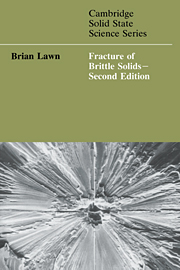Book contents
- Frontmatter
- Contents
- Preface
- Glossary of symbols and abbreviations
- 1 The Griffith concept
- 2 Continuum aspects of crack propagation I: linear elastic crack-tip field
- 3 Continuum aspects of crack propagation II: nonlinear crack-tip field
- 4 Unstable crack propagation: dynamic fracture
- 5 Chemical processes in crack propagation: kinetic fracture
- 6 Atomic aspects of fracture
- 7 Microstructure and toughness
- 8 Indentation fracture
- 9 Crack initiation: flaws
- 10 Strength and reliability
- References and reading list
- Index
4 - Unstable crack propagation: dynamic fracture
Published online by Cambridge University Press: 14 January 2010
- Frontmatter
- Contents
- Preface
- Glossary of symbols and abbreviations
- 1 The Griffith concept
- 2 Continuum aspects of crack propagation I: linear elastic crack-tip field
- 3 Continuum aspects of crack propagation II: nonlinear crack-tip field
- 4 Unstable crack propagation: dynamic fracture
- 5 Chemical processes in crack propagation: kinetic fracture
- 6 Atomic aspects of fracture
- 7 Microstructure and toughness
- 8 Indentation fracture
- 9 Crack initiation: flaws
- 10 Strength and reliability
- References and reading list
- Index
Summary
Thus far we have considered only static crack systems. Now, if an unbalanced force acts on any volume elements within a cracked body, that element will be accelerated, and will thereby acquire kinetic energy. The system is then a dynamic one, and the static equilibrium conditions of Griffith and Irwin–Orowan no longer apply. In certain instances, such as when stable cracks are made to grow slowly in controlled fracture surface energy tests, the kinetic energy component may be relatively insignificant in comparison with the system mechanical energy. The system may then be regarded as quasi-static, insofar as the static solutions describe the critical requirements for crack extension to sufficient accuracy.
There are two ways in which a crack system may become dynamic. The first arises when a crack reaches a point of instability in its length: the system acquires kinetic energy by virtue of the inertia of the material surrounding the rapidly separating crack walls. Such a dynamical state may be realised even under fixed loading conditions. A ‘running’ crack is typified by a rapid acceleration toward a terminal velocity governed by the speed of elastic waves. In most (but not all) test specimens the running crack divides the material into two or more fragments. The second type of dynamical state arises when the applied loading is subject to a rapid time variation, as in impact loading. In this case response may be limited by the characteristic duration of the loading pulse.
- Type
- Chapter
- Information
- Fracture of Brittle Solids , pp. 86 - 105Publisher: Cambridge University PressPrint publication year: 1993
- 1
- Cited by



